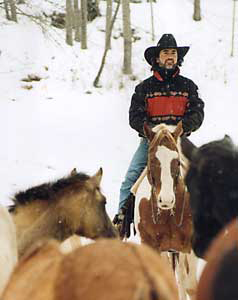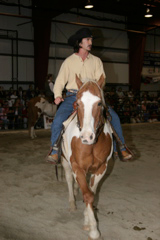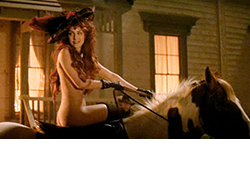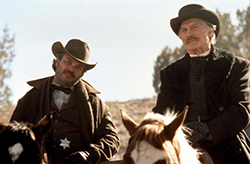 No matter how many horses might come into your life over the years, there will only be just one that is truly your horse, that one partner and companion you shared the better part of your life with, rode the most miles on, trusted your very life with, got to a place where you were so connected, you no longer had to give rein commands to – you thought about turning right and downshifting to a lope, and he just did it.
No matter how many horses might come into your life over the years, there will only be just one that is truly your horse, that one partner and companion you shared the better part of your life with, rode the most miles on, trusted your very life with, got to a place where you were so connected, you no longer had to give rein commands to – you thought about turning right and downshifting to a lope, and he just did it.
Chato Red Cloud, who went on last week at the amazing age of 36 – 100.5 in human years -was that one horse to me, and he always will be.
Chato came into my life in 1987 on the set of “Young Guns” in New Mexico. We had coaxed the legendary Jack Palance out of retirement to play western villain L.G. Murphy, a casting coup that I was very much excited about as a young gun myself, still in my 20’s.
On Jack’s very first day, he was to ride up on his horse, hit his mark, and deliver his lines. I remember how frustrated he was because the horse he was riding refused to stay on the mark and was constantly shifting and turning. After three aborted takes, one of our wranglers, Derwood Herring, Jr., called out in his Texas twang, “go git Tarzan!” Tar-Zan is how he pronounced it.
Moments later, the most beautiful American Paint horse I had ever seen was led out, saddled, and soon carrying Mr. Palance. On every take “Tarzan” not only hit his mark, he turned his head in handsome profile, held steady, and allowed Jack to deliver his lines without worrying about the horse.
At 9 years old, Tarzan had already appeared in Silverado and The Three Amigos. He was one of Derwood Herring’s most solid, reliable horses in his string.
My wife Richela, like me a lover of Native American horses, fell in love with this young tobiano paint at first sight. While she was admiring him between set-ups, Derwood the wrangler asked if she wanted to take him for a ride. Richela mounted and took off through the Santa Fe brasada. When she came back, she was beaming. “You have to ride this horse,” she said. “He’s amazing. The smoothest horse I’ve ever been on. And smart.”
And so I did. And over the next weeks, all Richela and I could talk about was this wise and mellow paint horse that was taking such great care of 71 year-old Jack Palance. I knew right away that I wanted him. But word was out that Jack had first dibs and was seriously thinking about buying him and taking him back to his Pennsylvania farm.
 In the end though, I had been showing Tarzan more interest and ultimately offered a higher price to win him. I was not going to let him go.
In the end though, I had been showing Tarzan more interest and ultimately offered a higher price to win him. I was not going to let him go.
I re-named him Chato after the Chiricahua Apache warrior and began riding him every weekend in the Galisteo Desert. He was my first horse and our friendship was forged quickly and deeply. Every cowboy or Native friend that I rode with was astounded by Chato, by his intelligence and calm. Even at a young age, he commanded respect and trust from horsemen. “That horse is one in a million,” is something I heard time and time again.
I remember one day, while out riding with my wife, a horse trainer friend named Robert, and some of his friends and their Arabian horses, Chato and I were feeling our oats. I had been studying my American Paint Horse book and was fascinated by a chapter about a half-Indian horseman named Frank Hopkins and his paint horse Hidalgo. It was the first time that I had learned the story of the Indian pinto who won an epic race in the Arabian desert against Arabian horses. So when these guys on their Arabians decided to pass me and Chato out and show us what they were made of, we both got fired up and ran with them. That was the day that I realized that Chato was not only the smoothest and most sound horse I’d ever been on – he was also the fastest.
 We left those Arabian horses in the dust. Robert gave me a good scolding for running full-out in the desert on his watch, but it was exhilarating and a day I’ll never forget. It was probably the day that the movie “Hidalgo” began to take root. I always called Chato “my Hidalgo.”
We left those Arabian horses in the dust. Robert gave me a good scolding for running full-out in the desert on his watch, but it was exhilarating and a day I’ll never forget. It was probably the day that the movie “Hidalgo” began to take root. I always called Chato “my Hidalgo.”
On that same day, that same ride in the Galisteo Desert, Chato came to a dead stop. He had kicked up some buried barbed wire that was so rusted it could have been from the 50’s. When I looked down I saw that the barbed wire was coiled several times around his front leg, biting deep, and drawing blood. “Get off. Now,” Robert said and I could see that he was unnerved. “Go easy, but get off right now.” When I did and stepped away, Robert – and everyone – watched in awe as Chato just stood there, turning his head to look at me, as if to say “take the wire off of me.”
Any other horse would have panicked and gone primal, Robert said. Ripped his leg apart and likely bled to death. Not this horse. “Never saw nothing like that in all my years,” Robert said. “You got y urself one smart horse.”
urself one smart horse.”
Slowly I removed the coils of embedded wire from Chato’s leg. He delicately lifted his leg for me so I could do the job. Blood ran but he remained calm.
When I took him back to Vermont and retired him on lush green grass I had some of the greatest rides of my life in the northern meadows and woods. We bonded more deeply, became horse and rider in the truest sense. I was spending a great deal of time in the Native American community and that experience informed and deepened my relationship with Chato. I spoke Lakota language to him, and rode him in ways taught to me by the plains Indian horsemen. He often participated in ceremonies when my Native relations came to visit, carrying children or elders to the sweat lodge site.
When “Young Guns” opened and was a hit, I was commissioned to write the sequel. When I wrote “a stunning American Paint Horse” into the script, it was a subtle plan to hire my own horse again and bring him with me back to New Mexico. I couldn’t stand to be apart from Chato.
In “Young Guns II” Chato carried actress Jenny Wright naked and side-saddle out of a burning brothel. How many horses can keep that kind of cool, take after take (see Entertainment Weekly’s tribute to Chato here.)
Again, Chato and I logged many hours in the New Mexico desert over the months we shot “Guns II.” When I brought him back to Vermont this time, I told him his acting days were done; he could rest now and fatten up on the green New England grass.
Chato and I were an anomaly in our Vermont farming community: A long-haired cowboy screenwriter on an American paint horse in Mexican saddle. But we proved ourselves together by rounding up runaway cows, entire herds, for local farmers. That was one of my favorite sports to do with Chato – there were few things he and I loved more and we were good at it together. I even took an ad out in the local paper offering our round-up services to dairy and cattle farmers (although no one ever called).
In April 2005, Chato was honored by the American Paint Horse Association when he was presented with registration papers before a large crowd at the Everything Equine horse show in Burlington, Vermont. Up to that point, Chato had been an unregistered horse with no recognized pedigree despite his beauty and stellar credentials. So it was a great moment to see him honored for his movie work by the APHA as I rode him before an enthusiastic crowd.
Chato lived to over 100 in human years. It seemed as though he was going to keep on going. He was still handsome and regal and so well taken care of on our land by my friends Joe and Gayle Streeter (thank you, Gayle!). To his last glorious summer day he was still the king.
He lived a wonderful life and was truly one in a million. He will always be my partner, the real Hidalgo. My one true horse.
Long may you run, Chato.
This song that Bryan Adams wrote for my movie “Spirit” is for you: http://www.youtube.com/watch?v=BajWH5OlOFI









